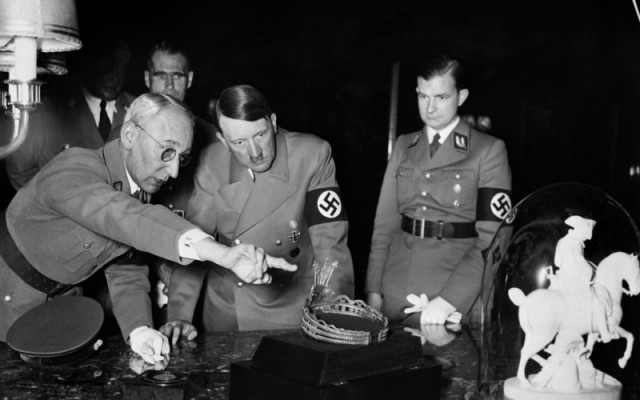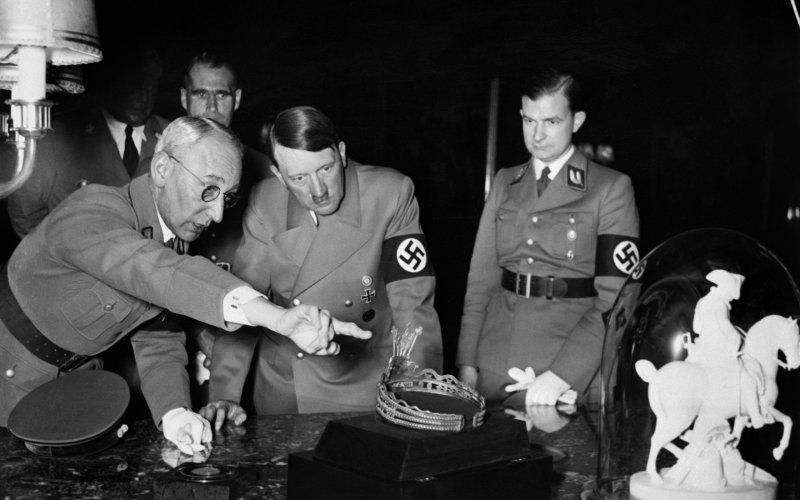
Before WWII broke out, German dictator Adolf Hitler had already this one dream he was passionate to come into fruition – his own “Super Museum” containing every Aryan-approved artwork found. American art historian and novelist Noah Charney reveals how the Monuments Men were able to uncover this Hitler project and its connection to Napoleon.
According to Charney, Monuments Men Robert Posey and Lincoln Kirstein found Harvard-educated Hermann Bunjes, who was an SS officer and had worked one time for Herman Goring as his art adviser, hiding in a white-washed cottage secluded in the German forest fearing that German citizens would attack him for being an SS officer.
The Secrets
Through him the two men learned about the elaborate plan Hitler had set out to do – putting up his “Super Museum” – which included the widespread looting of European art works by his henchmen.
Bunjes related to Posey and Kirstein, who both were art colleagues, information about the ERR, the Nazi art theft unit and Hitler’s intention of building his city-wide “Super Museum” in Linz, Austria – the town where he spent his childhood years.
This “Super Museum” would hold all the important artworks worldwide — both those which had the Aryan approval and the so-called “degenerate art”. These debauched artworks would have a wing devoted to showcasing them to allow the world to see what art horrors the Nazis were able to save it from.
What Herman Bunjes revealed to Posey and Kirstein was great news for the two Monuments Men who had to repress the shock at the idea laid out to them. They and their fellow Monuments Men colleagues had heard rumors about art looting and theft throughout the war but they never imagined it had a proportion as great as the one Bunjes admitted (some had estimated that about 5 million artistic objects were either stolen, lost or mishandled during WWII).
Based on Bunjes’ tale, the extensive looting of European art were carried out by an advanced level within the Nazi organization (a large number of Nazi soldiers and officers were assigned solely in the confiscation, transportation and the maintenance of the looted art and archival materials) and that their ultimate destination was Hitler’s “Super Museum”, the Führermuseum.
Posey and Kirstein’s talk with Bunjes was quite revealing. It was there that the two realized the great problem they were up against. However, the looting had already been going on for some time as the Monuments Men encounter with the former SS officer happened years into the war.
Bunjes had not only revealed Hitler’s extensive plan for a “Super Museum”, he also got to light several of the looted arts’ hiding places which including the well-known salt mine at Altaussee found in the Austrian Alps. the said location housed about twelve thousand stolen artworks, the prime load for the planned city-wide museum at Linz.
Posey and Kirstein had been running after The Ghent Altarpiece, a Jan van Eyck work which was, perhaps, the most influential painting ever made and was also the most recurrently stolen masterpiece. What startled them was that it was no. 1 in Hitler’s list of to-be looted artwork — he wanted it to be the centerpiece of his “Super Museum” not just because of its importance, beauty or fame but because he felt that bringing it back to Germany would correct the wrong the Treaty of Versailles did to the German people when the said document forcibly repatriated this van Eyck masterpiece to Belgium.
To Posey and Kirstein, it was not just a case of saving The Ghent Altarpiece anymore. It was the chance of saving other art masterpieces as well.
The Fuehrer’s “Super Museum”
German dictator Adolf Hitler’s plan of a “Super Museum” had been playing in his mind for over a decade, at least, by 1934. It was this same time that the Fuehrer sent Nazi investigator (and a lookalike) Heinrich Köhn to Ghent to find the missing panel of the altarpiece, the Righteous Judge panel, which got stolen from the St. Bravo Cathedral in Ghent in 1934 and was never recovered.
It is believed that Köhn was sent to look for that missing piece before the Nazis took away the remaining panels. Logic-wise, they would really look for the missing piece as they had already the intention of taking the rest of The Ghent Altarpiece once the opportunity presented itself.
Hitler’s “Super Museum” was to take up most of Linz changing it from a working-class town into a cultural center that could rival and even defeat Vienna; Hitler had fancied that idea ever since he failed to get into an art school in the city (this was before he launched his political career) and the rejection made him feel like he was a second-class citizen.
The museum complex, designed by Alex Speer, was to include an opera house, a hotel, a parade ground, theater, a library which could house volumes as many as a quarter of a million and of course, the museum with its five hundred-foot facade with colonnades in the grand Fascist Neo-Classical style. The plan included about 36 kilometers of galleries (London’s V&A Museum has about 8 kilometers of galleries) and these galleries were to showcase 27,000 art objects.
It was on June 21, 1939 when Hitler put up the special delegation which would manage the Linz project 0 the making of his “Super Museum”. That was before he handled the looted and stole the art pieces to fill it up. Then from fall of 1940 on (most often at Christmas as presents), Hitler received construed photo albums full of images of looted art pieces which could be featured inside his Führermuseum. He received a total of 31 albums with 19 surviving to this day.
The Fuehrer found pleasure and comfort looking over these albums and the blueprint of his “Super Museum”; it was even said he had these brought with him and looked over before he committed suicide in his own bunker.
Hitler, Napoleon and the Appeal of the “Super Museum”
The German Historical Museum had set out a project in 2008 which would recreate a virtual version of Hitler’s Führermuseum, specifically, its collection. The project’s online database shows looted art pieces between 1930 to 1945 giving those who look into it an idea of what the Fuehrer had wanted to put up in his “Super Museum”.
Charney admitted in his writing that though Hitler’s ways to translate his plan into reality were wretched, Hitler’s concept of a “Super Museum”, and how it would bring all the world’s cultural objects under one roof, was really interesting.
But for all the Fuehrer did for this single desire, he wasn’t the first one to come out with it.
Jean-Dominique Vivant Denon, Louvre Museum’s first director, was planning of the same thing. Being Napoleon’s chief art adviser, he had put up an art wish-list – art pieces that he wanted to have should they fall into the paths of either the emperor or his forces.
The first French emperor also was the first one to have a committed art theft unit within his army. He even accepted art pieces as a form of a truce; if you wanted him to stop shooting you then provide an artwork he would like. Napoleon’s art theft unit was the one liable for thousands of art masterpieces’ confiscations especially within Italy. He even required those from whom he confiscated the art pieces to pay for the shipment of these objects to Paris as a way to rub salt over the wound. The Vatican had to come up with money equivalent to $2.3 million in today’s currency to cover the costs of over a hundred artworks Napoleon team chose to be brought back to the Louvre after the Treaty of Tolentine.
Thus, it can be said that Hitler’s plan was the same as what Denon had thought of for Louvre one hundred and fifty years prior to WWII though the latter was more elaborate.
How Hitler’s “Super Museum” Would Have Looked Like
Can you envision yourself walking through the galleries of Hitler’s museum would it have been successfully put up today? What art masterpieces would you have seen?
Nazis were strongly inclined to artists and subject matters that they considered Teutonic or Scandinavian. They favored the works of Dürer, Cranach, Friedrich and van Eyck. Rembrandt on the other hand got mixed Nazi reviews – some saw him as too Jewish while others looked up to him as the ultimate Aryan artist.
Hitler’s “Super Museum” would have showcased a collection that would be both universal and extensively coming from various eras and nations but with emphasis on the Northern Renaissance and the Teutonic tradition as the cream of the crop.
Nazis preferred naturalism over abstraction so the degenerate wing of this said “Super Museum” would have showcased abstracts, minimalists, cubists, impressionists, and post-impressionists German artists or not. German painters who were into these kinds of works were deemed as “bad” as their foreign, frequently Jewish, counterparts.
The scale of the collection found in Hitler’s “Super Museum” would have been huge as well as curated in a moralistic and schoolish manner pointing out the pieces that the people should and must like.
The Ghent Altarpiece would have stood at the center of Hitler’s “Super Museum” showing proof that the Fuehrer was able to save Germany from First World War’s humiliation and was also the perfect specimen of a work done in a naturalistic Northern Renaissance style by someone who was of the Teutonic lineage.
A visit to the Führermuseum would have been terrifying but at the same time fascinating.
Charney finished off his piece with these words:
“We have the Allied heroes—Monuments Men, soldiers, officers, and countless under-sung citizens—to thank for saving Europe’s art, and the world. But the haunting concept of a “super museum” remains.”
